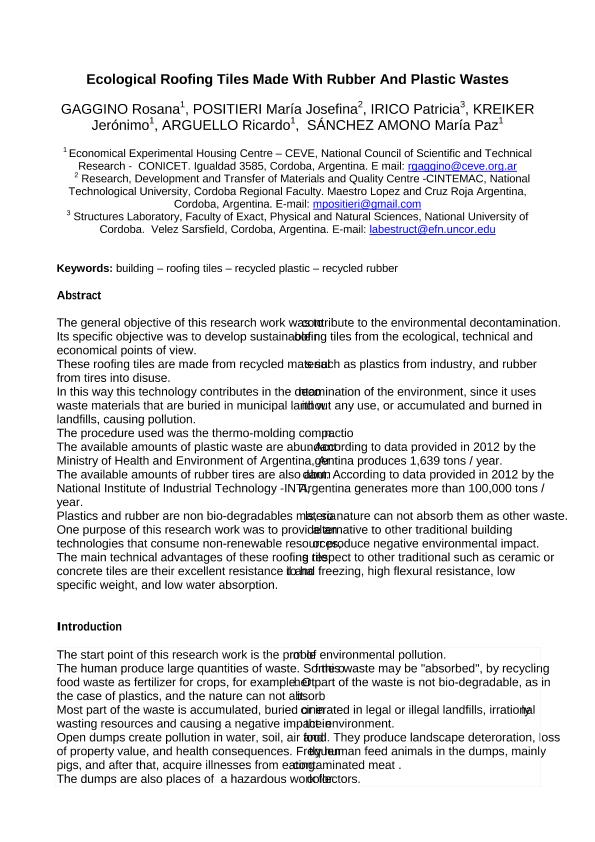Artículo
Ecological roofing tiles made with rubber and plastic wastes
Gaggino, Rosana ; Positieri, María Josefina; Irico, Patricia; Kreiker, Jeronimo Rafael
; Positieri, María Josefina; Irico, Patricia; Kreiker, Jeronimo Rafael ; Arguello, Ricardo Gustavo
; Arguello, Ricardo Gustavo ; Sanchez Amono, Maria Paz
; Sanchez Amono, Maria Paz
 ; Positieri, María Josefina; Irico, Patricia; Kreiker, Jeronimo Rafael
; Positieri, María Josefina; Irico, Patricia; Kreiker, Jeronimo Rafael ; Arguello, Ricardo Gustavo
; Arguello, Ricardo Gustavo ; Sanchez Amono, Maria Paz
; Sanchez Amono, Maria Paz
Fecha de publicación:
11/2013
Editorial:
Trans Tech Publications
Revista:
Advanced Materials Research
ISSN:
1662-8985
Idioma:
Inglés
Tipo de recurso:
Artículo publicado
Clasificación temática:
Resumen
The general objective of this research work was to contribute to the environmental decontamination. Its specific objective was to develop sustainable roofing tiles from the ecological, technical and economical points of view.These roofing tiles are made from recycled materials such as plastics from industry, and rubber from tires into disuse. In this way this technology contributes in the decontamination of the environment, since it uses waste materials that are buried in municipal land without any use, or accumulated and burned in landfills, causing pollution. The procedure used was the thermo-molding compaction. The available amounts of plastic waste are abundant. According to data provided in 2012 by the Ministry of Health and Environment of Argentina, Argentina produces 1,639 tons / year. The available amounts of rubber tires are also abundant. According to data provided in 2012 by the National Institute of Industrial Technology -INTI, Argentina generates more than 100,000 tons / year. Plastics and rubber are non bio-degradables materials, so nature can not absorb them as other waste. One purpose of this research work was to provide an alternative to other traditional building technologies that consume non-renewable resources, or produce negative environmental impact. The main technical advantages of these roofing tiles respect to other traditional such as ceramic or concrete tiles are their excellent resistance to hail and freezing, high flexural resistance, low specific weight, and low water absorption.
Palabras clave:
Building
,
Roofing Tiles
,
Recycled Plastic
,
Recycled Rubber
Archivos asociados
Licencia
Identificadores
Colecciones
Articulos(CEVE)
Articulos de CENTRO EXPERIMENTAL DE LA VIVIENDA ECONOMICA(I)
Articulos de CENTRO EXPERIMENTAL DE LA VIVIENDA ECONOMICA(I)
Citación
Gaggino, Rosana; Positieri, María Josefina; Irico, Patricia; Kreiker, Jeronimo Rafael; Arguello, Ricardo Gustavo; et al.; Ecological roofing tiles made with rubber and plastic wastes; Trans Tech Publications; Advanced Materials Research; 844; 11-2013; 458-461
Compartir
Altmétricas



